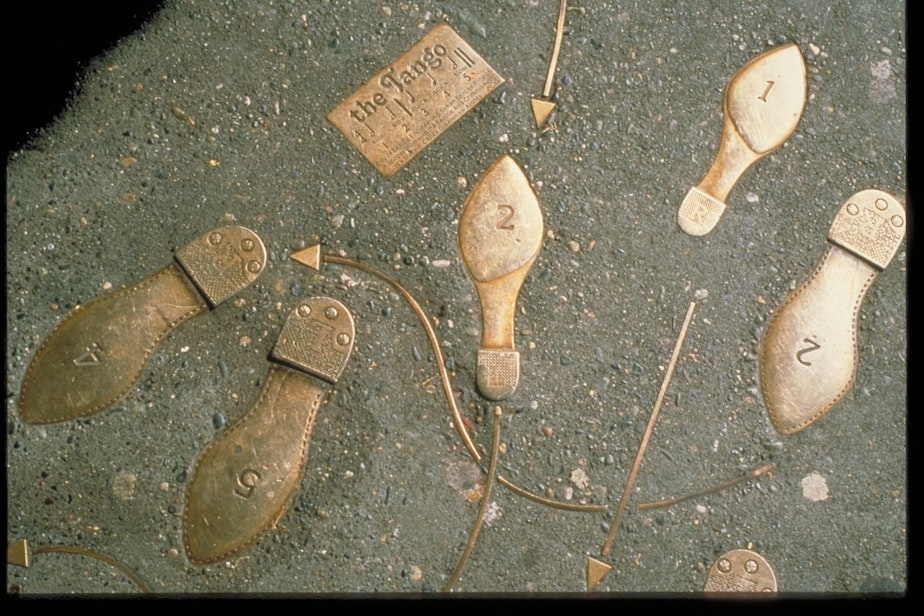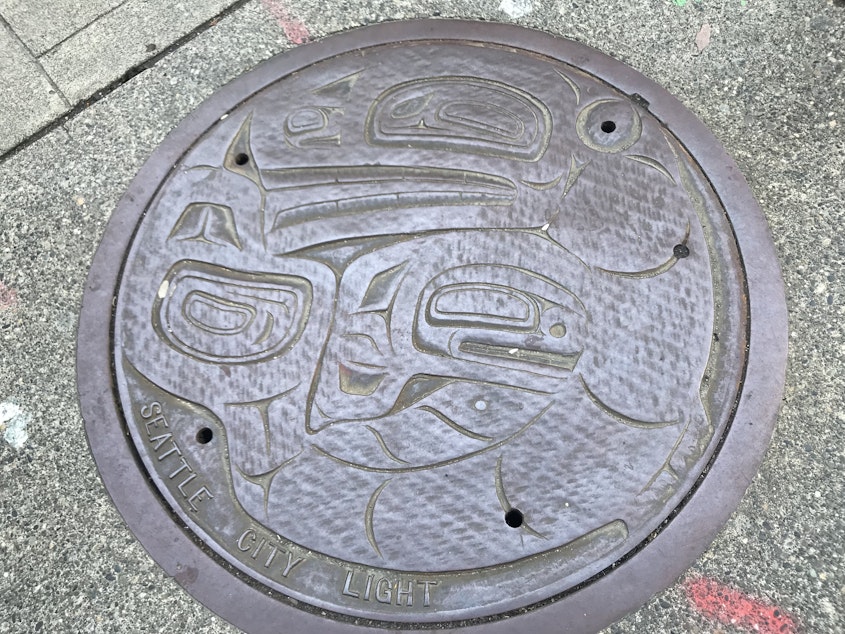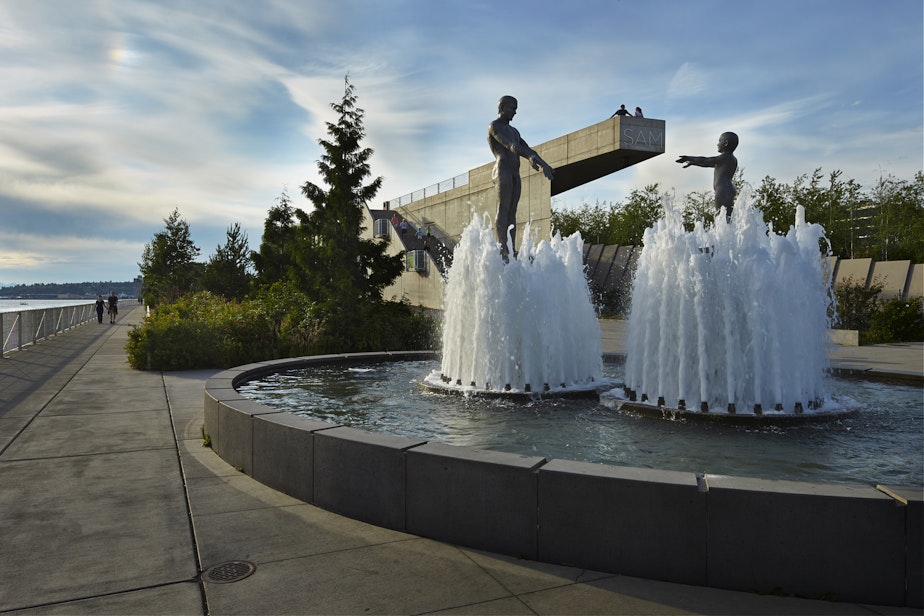The story behind those bronze dance steps on Capitol Hill
It’s a chilly, late winter morning outside a major construction site on Capitol Hill, and Jack Mackie is fretting about the artwork he installed at the site 40 years ago.
A construction crew is working on a new apartment complex atop the light rail station here, and Mackie wants to make sure the landscape artists aren't replacing the sidewalk.
This is critical, because Mackie’s artwork, “Dance Steps on Broadway,” is embedded in the concrete. This particular iteration, the Tango, is actually one of a nine-part series of cast bronze footprints dispersed along 12 blocks of this busy thoroughfare. Each is a numbered diagram of a dance—tango, waltz, cha-cha.
There’s even a dance Mackie invented: He calls it the "bus stop."
“It’s kind of mirroring the traditional dance pedestrians do waiting for a bus,” Mackie explains. He demonstrates the steps. “Backing up, looking out at the street. Step out, step back, then say ‘the bus isn’t coming, so I’ll just walk.’”
“Dance Steps on Broadway” is one of the first public art projects funded by Seattle’s Percent for Art Ordinance. The law, enacted in 1973, mandates that 1 percent of the budgets of certain city capital projects be set aside for artworks at those projects.
Seattle had an array of art in public places before the ordinance, but primarily they were statues of important historical figures, or discreet sculptures donated by private collectors. The public art ordinance’s authors were inspired by a grander idea—to weave art and design into the city’s infrastructure projects.

“Dance Steps” was born out of a major project to move Broadway’s electrical cables underground. Mackie says he and the project architects and engineers were interested in art that might enhance the pedestrian experience. The first Seattle design team project, also completed in 1979, was at the Viewland/Hoffman electrical substation in north Seattle.
“I think the framers of the ordinance were really thinking about the social purpose of art,” says Ruri Yampolsky, who directs the Public Art Program for Seattle’s Office of Arts and Culture. “Seattle was one of the first programs to conceive of the idea of a design team, where the artist would be working collaboratively to really integrate the artwork.”
Sponsored
Although Seattle wasn’t the first place in the country to adopt a percent for art ordinance (Philadelphia and the state of Hawaii preceded it), the law had some uniquely ambitious goals: “The City accepts a responsibility for expanding public experience with visual art,” the ordinance reads. “Such art has enabled people in all societies better to understand their communities and individual lives.”
The late Paul Schell, Seattle mayor from 1998 to 2002, helped write the ordinance when he headed the civic group Allied Arts. In a 2005 interview, Schell said the legislation was inspired by Seattleites’ decision to preserve the Pike Place Market.
“They were sort of a philosophical statement about what kind of city do we want to be,” Schell said. “In both instances it empowered citizenship and said what we thought was important.”
For Schell and his Allied Arts colleagues, the ordinance symbolized Seattle’s commitment not simply to maintain the public infrastructure, but to provide food for the civic soul.
Over almost 50 years, Seattle’s public art ordinance has funded more than 400 permanent public artworks, from mosaics in local parks to artwork at fire and police headquarters. It has paid for temporary projects as well, along with what the city calls its portable public works collection: smaller works that are often on display in civic offices.
Sponsored
All of this is in addition to public art created under the auspices of programs run by King County, the Port of Seattle, the State of Washington and Sound Transit, as well as the city’s Department of Neighborhoods. That adds up to a lot of art in Seattle’s public spaces.
Yampolsky, Seattle Public Art program director, believes the wealth of public works has inspired developers to include art in their private projects.
“If you look at all the development happening in South Lake Union, there are significant artwork projects happening in the buildings,” she says. “I think what Seattle has is this understanding that art really can enhance one’s basic quality of life.”

That’s not to say all of Seattle’s public art has been welcomed with open arms.
In 2004, as part of a wide-ranging lawsuit, a group of Seattle City Light ratepayers challenged the utility’s inclusion in the Percent for Art program. While a judge eventually ruled that Seattle was within its rights to include City Light capital projects, the scope of the utility’s public artwork was adjusted to focus exclusively on its mission.
Although not every unpopular public artwork has sparked litigation, individual pieces located in the public arena have often been vilified — at first. A fountain of two nude male figures, created by internationally-known sculptor Louise Bourgeois, was denounced when it was installed at Seattle Art Museum’s Olympic Sculpture Park. Now the fountain is one of dozens of permanent and temporary works that draw thousands of visitors to the Sculpture Park every year.

Even Mackie’s “Dance Steps” got pushback from some Capitol Hill residents before its installation.
“We were at a community meeting up here,” Mackie recalls. “And someone in the crowd stood up and said, ‘This is an outrage! It will make people trip and fall over!’”
But forty years after Mackie installed his bronze footsteps, not only has nobody filed a complaint about tripping; the "Dance Steps" have reached community icon status. Pedestrians often stop to study the diagrams, wearing down the bronze with their attempts to tango or waltz. And at least one local organization appropriated a photo of the art for a marketing brochure (for which Mackie sued successfully that it was a case of intellectual property infringement).
But for Mackie, creating the "Dance Steps on Broadway" led to a career working almost exclusively on public art and design projects. He says it forced him to put aside his ego and create work for the public.
Mackie traces his satisfaction to the day crews installed the first of the nine dances in the sidewalk.
“One of the guys pouring the concrete came running over,” Mackie says. “He said ‘I was looking at the sidewalk, and there was a guy on his hands and knees there.’”
The construction worker assumed the man was drunk, then took a closer look, according to Mackie. He was a blind man who had gotten close to the art, in order to run his fingers over the bronze steps.
“At that point I said to myself ‘job done. I can go home now.’”




